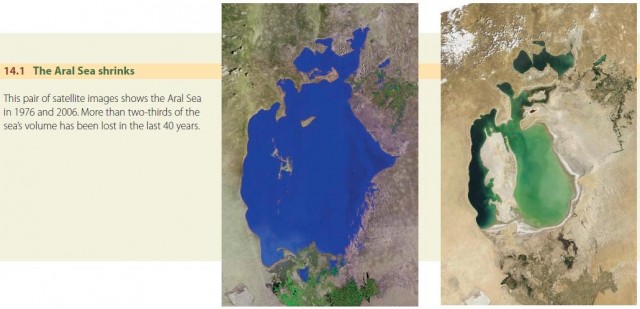The Aral Sea
East of the Caspian Sea, astride the former Soviet republics of Kazakhstan and Uzbekistan, lies an immense saline lake—the Aral Sea. Fed by meltwaters of high glaciers and snowfields in the lofty Hindu Kush, Pamir, and Tien Shan Ranges, the lake endured through thousands of years as an oasis for terrestrial and aquatic wildlife deep in the heart of the central Asian desert.
But in the last 40 years, the Aral Sea, once larger than Lake Huron, has shrunk to a shadow of its former extent (Figure 14.1). The volume of its waters has decreased by more than two-thirds, and its salinity has increased from 1 percent to over 3 percent, making it more salty than sea water. Twenty of the 24 fish species native to the lake have disappeared. Its catch of commercial fish, which once supplied 10 percent of the total for the Soviet Union, has dwindled to zero. The deltas of the Amu Darya and Syr Darya rivers, which enter the south and east sides of the lake, were islands of great ecological diversity, teeming with fingerling fishes, birds, and their predators. Now only about half of the species of nesting birds remain. Many species of aquatic plants, shrubs, and grasses have vanished. Commercial hunting and trapping have almost ceased.

What caused this ecological catastrophe? The answer is simple—the lake's water supply was cut off. As an inland lake with no outlet, the Aral Sea receives water from the Amu Darya and Syr Darya, as well as a small amount from direct precipitation, but it loses water by evaporation. Its gains balanced its losses, and, although these gains and losses varied from year to year, the area, depth, and volume of the lake remained nearly constant until about 1960.
In the late 1950s the Soviet government embarked on the first phases of a vast irrigation program, using water from the Amu Darya and Syr Darya for cotton cropping on the region's desert plain. The diversion of water soon became significant as more and more land came under irrigation. As a result, the inflow fell to nearly zero by the early 1980s. The surface level of the Aral was sharply lowered and its area reduced. The sea became divided into two separate parts.
As the lake's shoreline receded, the exposed lakebed became encrusted with salts. The once-flourishing fishing port of Muynak became a ghost town, 50 km (30 mi) from the new lake shoreline. Strong winds now blow salt particles and mineral dusts in great clouds southwestward over the irrigated cotton fields and westward over grazing pastures. These salts—particularly the sodium chloride and sodium sulfate components—are toxic to plants. The salt dust permanently poisons the soil and can only be flushed away with more irrigation water.
However, a portion of this vast ecological ruin is now in rehabilitation. The flow of the Syr Darya reaching the lake is sufficient to maintain the smaller northern section of the lake, now called the Small Sea, in a productive state. A dike some 13 km (8 mi) now separates the Small Sea from its larger brother, the Big Sea. The dike traps the inflowing waters of the Syr Darya and by 2006 had raised the level of the Small Sea from 30 m (98 ft) to 38 m (125 ft), with 42 m (138 ft) considered the level of viability.
In 2006, commercial fishing returned to the Small Sea. A new fish hatchery is under construction, with a target of producing 10,000 tons of sturgeon, carp, and flounder each year. This is about half the former yield of the whole Aral Sea. The local population, which was decimated as their livelihood faded away, is now coming back, with some villages doubling their populations within a few years. The increased water surface area has stimulated increased rainfall downwind of the sea, helping local agriculture.
But what of the Big Sea? Unfortunately, its prospects are dim. At a salinity level of more than 85 parts per thousand (more than twice as salty as ocean water), the last of its native fish species are dying. Still, there is some hope for the Big Sea's fishermen. When the salinity reaches 110 parts per thousand, conditions will be favorable for brine shrimp. These tiny creatures are used as food for young fishes raised in fish farms worldwide and can provide a valuable cash crop. However, there will be no respite from the toxic dust storms of salt and pesticide residues that sweep over the region downwind from the Big Sea.